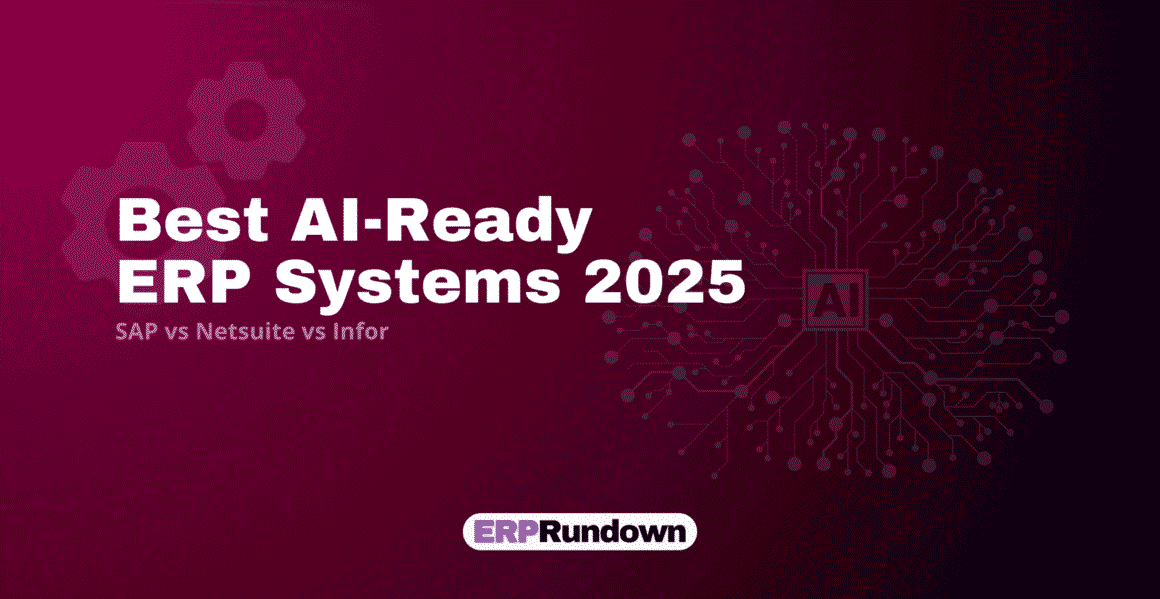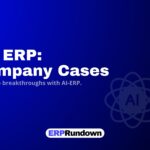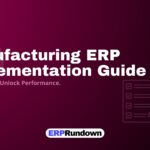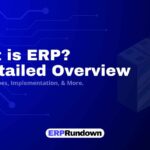Best AI-Ready ERP Systems: SAP vs Infor vs NetSuite
ERP systems are no longer just data repositories or process managers, they’re becoming enterprise intelligence engines. AI-driven automation is a strategic differentiator for modern business operations. Similarly, AI-readiness in ERP systems is now one of the baseline requirements for ERP buyers.
But what does AI-Ready ERP actually mean?
AI in ERP it’s not just about throwing in a few smart dashboards or predictive reports. An AI-ready ERP embeds machine learning (ML), real-time data pipelines, native automation, and the ability to deploy and manage custom or pre-built models—without third-party patchwork.
There’s a clear distinction between:
- ERPs that embed AI capabilities at the core vs. those that rely on bolt-on AI tools
- Rule-based automation vs. predictive intelligence vs. generative AI
Gartner projects that by 2026, over 80% of enterprises will operationalize AI-powered applications in at least one key business module (like planning, procurement, or service delivery).
Let’s take an in-depth, vendor-agnostic look at three of the most enterprise-relevant, AI-ready ERP systems—SAP S/4HANA, Infor CloudSuite, and Oracle NetSuite. This is not a high-level product comparison. You’ll find a technical, use-case-focused, and unbiased analysis to align your ERP investments with business-relevant AI capabilities.
What Makes an ERP System ‘AI-Ready’?
Not all ERP platforms with “AI features” qualify as AI-ready. True readiness goes beyond marketing claims and flashy interfaces. It requires architectural alignment, process-level automation, and AI lifecycle management capabilities.
Let’s break AI-readiness in ERP systems into 5 core pillars.
- AI Capability Architecture (Native vs. Add-on)
AI-ready ERPs embed intelligence into the core product architecture like pre-integrated ML engines, AI service layers, and model orchestration tools.
In contrast, bolt-on solutions (common in legacy ERPs) add latency, break data integrity, and demand more IT maintenance. Native AI eliminates these friction points.
- Mature Data Architecture
An AI-ready ERP needs a real-time, unified data layer—not siloed modules. Semantic models, data lakehouse integration, and event-driven pipelines are essential for feeding high-volume, high-velocity data into ML models. SAP’s Universal Journal and Infor’s Enterprise Data Fabric are excellent examples of this maturity.
- Automation + ML Workflow Depth
RPA (Robotic Process Automation) isn’t AI. AI-ready ERPs use ML pipelines, NLP-powered process flows, and self-adaptive algorithms to move from basic automation to intelligent decision-making. AI-powered ERP system supports:
- Workflow orchestration with ML triggers
- AutoML or custom model deployment
- Intelligent exceptions (vs. static rules)
- ML Lifecycle & Model Ops
Modern ERPs should offer AI model training, testing, deployment, and feedback loops natively. This includes:
- Model retraining pipelines
- AutoML tools (for citizen developers)
- ML Ops governance (for regulated industries)
Without this, businesses face technical debt or reliance on external data science platforms—slowing time-to-value.
- Verticalized AI Use Cases
Finally, true AI-readiness is industry-contextual. Whether it’s demand sensing in manufacturing, revenue cycle automation in healthcare, or AI-driven dynamic pricing in retail—vertical use cases drive real ROI.
So, during AI-ready ERP selection remember that a dashboard is not AI. Reports showing trends don’t equal predictive insights. And RPA bots mimicking keystrokes don’t reflect intelligent automation.
AI-Ready ERP Comparison: SAP vs NetSuite vs Infor
Here’s a detailed breakdown on each AI-ready ERP system available.
- SAP S/4HANA
SAP powers the digital core of nearly 78% of Fortune 100 companies, making it a top-tier ERP choice for enterprises aiming to scale with AI-ready infrastructure and deep process automation
AI Capabilities & Technical Architecture
SAP S/4HANA delivers enterprise-grade, AI-ready ERP through a tightly integrated architecture backed by the SAP Business Technology Platform (BTP)—a scalable, production-grade environment for designing, training, deploying, and governing AI models directly within operational workflows.
The SAP AI Core acts as a central hub for AI lifecycle orchestration. It supports the deployment of both SAP-delivered and custom-built models with robust monitoring, versioning, and MLOps tooling. Unlike lightweight plug-ins common in mid-market ERPs, SAP’s AI architecture operates natively across transactional, operational, and analytical layers—making it foundational, not superficial.
New advancements include Joule AI agents, SAP’s domain-aware AI copilots that understand your business processes, maintain secure access to enterprise data, and support over 1,300 AI-driven skills. These agents execute routine transactional and navigational tasks up to 90% faster across supply chain, finance, procurement, and customer service.
Business Application
In finance operations, S/4HANA automates invoice processing by combining computer vision, NLP, and workflow management. It extracts unstructured data from PDFs, validates it against purchase orders, and executes payments—all without manual effort. This not only accelerates cycle time but also eliminates common human errors that lead to reconciliation delays.
Industry & Functional Depth
SAP’s AI is designed to match industry-specific needs, not a generic solution for everyone.
In discrete manufacturing, SAP uses predictive quality inspection powered by ML to detect process anomalies and prevent defects before they affect throughput. For energy and utilities, AI models embedded in the ERP dynamically optimize asset performance and energy loads to reduce OpEx and carbon footprint.
Public sector agencies use SAP’s AI to automate citizen service workflows, such as license processing and public resource planning for better service delivery without expanding headcount.
These aren’t pilot-stage concepts—they are enterprise-deployed models that scale to terabytes of structured and unstructured data across departments and geographies.
Integration with Business Workflows
What sets SAP apart is its deep AI workflow integration, not siloed AI features. Through tools like SAP Process Automation and Intelligent Robotic Process Automation (iRPA), AI is embedded directly into mission-critical workflows such as order-to-cash, demand planning, and customer support ticketing.
SAP’s support for human-in-the-loop intervention ensures compliance and audit readiness for high-stakes decisions. Its low-code/no-code interface empowers non-technical teams to adapt and optimize AI-enabled processes independently, significantly accelerating enterprise-wide adoption.
Custom AI Development Flexibility
SAP recognizes that off-the-shelf AI can’t address every business need. That’s why BTP and SAP AI Core support full open-source integration with TensorFlow, PyTorch, Python, and other frameworks. This empowers businesses to deploy custom AI models—from proprietary forecasting engines to AI-driven product configuration rules—inside their ERP stack without compromising governance.
Moreover, BTP offers federated data access across SAP and third-party sources, making it easier to train high-quality models without data migration hassles
Limitations & Key Considerations
Despite its enterprise-grade capability, SAP S/4HANA’s AI infrastructure demands mature internal readiness. Organizations need in-house data science or MLOps expertise and cross-functional alignment to operationalize AI at scale.
Cost is another consideration. Licensing, implementation, customization, and ongoing change management can push total ownership into the multi-million-dollar range. SMBs or businesses without established digital maturity may find value realization challenging without strong internal or partner support.
Lastly, SAP’s AI stack is deeply tied to its ecosystem. While this ensures high performance and seamless integration, it may reduce flexibility for organizations seeking vendor-agnostic interoperability. Custom APIs or middleware are often required for cross-platform coordination.
Forward-Looking Scope
SAP continues to expand its AI footprint with 130+ live AI scenarios and a roadmap of over 400 AI use cases by 2025, making it one of the most comprehensive AI portfolios across any ERP vendor. Moreover, SAP’s open collaboration with leading AI and LLM providers ensures access to frontier AI innovation embedded securely within its platform for redefined competitiveness.
See how leading enterprises are already using AI-powered ERPs.
- Infor CloudSuite AI ERP
CloudSuite embeds AI across core operations to reduce waste, improve planning precision, and scale intelligent automation—purpose-built for complex industries.
Explore Infor’s Enterprise AI capabilities.
AI Platform Overview
Infor CloudSuite is an AI-ready enterprise-grade ERP that integrates AI directly into its architecture, formerly under the name Coleman AI, now streamlined as Infor AI. This AI is not an add-on or middleware but an embedded layer that enhances operational workflows, forecasting models, and automation.
It comes with extensive industry-specific ML use cases and continues expanding, particularly in supply chain, manufacturing, healthcare, and food processing sectors. These models are pre-trained and designed to act on real-time transactional data to make decisions that are not based on stale or isolated data sets.
Unlike external AI plug-ins, Infor AI’s embedded nature reduces latency and complexity. For instance, it analyzes production line performance in real time and triggers asset maintenance to reduce unscheduled downtime and eliminate manual monitoring.
Enterprise Data Fabric
Infor’s enterprise OS platform is the backbone for its AI capabilities. This layer integrates transactional, historical, and third-party data through a unified data fabric. It maintains model accuracy by feeding consistent, structured inputs into ML algorithms. Through embedded data governance and real-time synchronization, businesses avoid the common pitfalls of data silos and outdated ETL pipelines.
This is particularly impactful in industries like food processing, where even slight yield inefficiencies directly impact profitability.
As shown in Infor’s customer case study, Amalthea, a Dutch cheese manufacturer, used Infor AI to optimize cheese yield by adjusting rennet enzyme usage. The AI processed sensor data and production KPIs to recommend precise dosing rates, reducing waste and improving sustainability. This resulted in €500,000 in annual savings for every 1% increase in yield and enabled 7x faster identification of yield deviations, moving from weekly to daily analysis.
Industry-Specific Use Cases: Practical AI Where It Matters
CloudSuite focuses on applied intelligence—not generic AI models. Every AI module is tightly aligned to a business function within a specific vertical. A few practical, enterprise-grade use cases include:
- Manufacturing: Predictive maintenance and optimized production schedules based on real-time machine learning algorithms. Infor AI detects early-stage anomalies in asset behavior and dynamically adjusts maintenance schedules, reducing equipment failure rates.
- Healthcare: Labor forecasting models optimize staff allocation based on patient inflow trends and regulatory compliance needs. This not only reduces overtime but ensures safer nurse-to-patient ratios.
- Food & Beverage: Yield optimization models ingest production metrics, supplier quality, and environmental variables to maximize output per raw material batch.
- Distribution & Supply Chain: AI-driven demand sensing adjusts procurement plans based on market shifts, customer demand trends, and supplier lead-time variability.
Each use case is backed by data pipelines and model governance within Infor OS, allowing real-time insights without requiring deep technical reconfiguration.
Customization, Model Deployment, & Extensibility
Infor CloudSuite offers significant flexibility through both no-code and low-code environments. Users can automate decisions like invoice matching, purchase order approvals, or staff scheduling without writing code. For advanced requirements, the platform supports seamless integration with external ML services such as AWS SageMaker and Microsoft Azure ML.
Data scientists can also plug in custom models via APIs for companies to easily bring proprietary algorithms—such as price optimization engines or custom forecasting models—into Infor’s AI runtime. However, enterprise-grade tuning still requires familiarity with Infor’s data services and business logic through tight collaboration between business and technical teams for high-impact deployments.
Challenges & Implementation Considerations
While Infor CloudSuite offers strong embedded AI capabilities, it is primarily optimized for customers within its targeted verticals. Businesses in non-core industries may find fewer ready-made AI use cases or require more manual customization.
Additionally, while the no-code AI workflows are accessible, deeply customized AI models—especially those requiring cross-functional data stitching or non-standard KPIs—may require external tooling or integration support.
Another consideration is the dependency on Infor OS for seamless AI operations. Companies with fragmented system landscapes or legacy data practices may need to invest in foundational data architecture upgrades before realizing full AI value.
- Oracle NetSuite
NetSuite AI supports intelligent automation across transaction-heavy business units with built-in forecasting, anomaly detection, and recommendations to improve decision accuracy and operational speed.
AI Capabilities & Scope
Oracle NetSuite integrates AI features primarily through Oracle’s broader cloud services rather than as native, deeply embedded components within the ERP itself. NetSuite AI functionalities focus on transactional efficiency and operational intelligence, particularly in financial processes.
This includes anomaly detection in general ledger entries, transaction categorization, expense fraud prediction, and payment delay forecasting to financial teams with faster and more reliable insights to act on. These capabilities are packaged as part of intelligent dashboards and KPIs but require supplemental Oracle Cloud AI add-ons for advanced functionality.
Business Use Cases
NetSuite’s AI tools are most impactful in finance-heavy workflows. For instance, in the order-to-cash cycle, NetSuite AI models predict invoice delays based on historical customer behavior, seasonal trends, and payment history.
This enables businesses to improve DSO (Days Sales Outstanding) and proactively manage working capital. In expense management, machine learning algorithms flag anomalies such as duplicate submissions or policy violations to cut manual auditing efforts.
During period-end close, AI forecasts potential bottlenecks by analyzing journal approval lags and task completion rates to help teams easily resolve issues before deadlines.
Integration-Driven AI Model Access
NetSuite relies heavily on external AI services for scalable automation. Oracle Cloud Infrastructure (OCI) AI services and connectors to platforms like AWS SageMaker and Google Vertex AI enable users to build and deploy machine learning models, but only through additional configurations and licensing.
While this adds flexibility for businesses with technical AI expertise, it also shifts the burden of implementation, monitoring, and governance onto the customer—unlike platforms with embedded AI pipelines built into their data fabric.
Data Architecture &Model Operationalization
NetSuite’s modular architecture supports multiple business functions, but this modularity can lead to data fragmentation when not centralized properly. AI use cases that depend on real-time contextual data—such as demand forecasting or procurement optimization—can suffer from latency or incomplete datasets unless organizations invest in building unified data lakes.
Additionally, NetSuite lacks a native MLOps framework for continuous AI model training, feedback loops, and performance tracking, which limits its application for adaptive, real-time systems.
While NetSuite offers flexible deployment and AI capabilities, understanding the cost-to-value ratio is key—especially for mid-sized firms with scaling budgets. Explore our full NetSuite pricing guide.
Practical Limitations for AI-Driven Enterprises
For mid-market businesses with finance-focused operations, NetSuite’s AI capabilities offer substantial value in automating routine tasks and providing predictive insights. However, enterprises requiring end-to-end AI integration—especially across manufacturing, supply chain, or product lifecycle management—may find the system lacking.
Without embedded AI across core operational modules or real-time learning mechanisms, NetSuite’s AI offering remains more of an enhancement layer than a foundational driver of business transformation.
Critical Evaluation: SAP vs Infor vs NetSuite
- Native AI Maturity
SAP S/4HANA leads with full lifecycle AI baked into its Business Technology Platform (BTP)—not just bolt-on modules. From ingestion to inferencing, it supports prebuilt and custom ML models across logistics, finance, and operations. This isn’t narrow automation—it’s enterprise-grade AI at scale.
Infor CloudSuite is purpose-built around industry-specific AI. Its Coleman AI offers low-code/no-code tools embedded into critical workflows like production scheduling, labor planning, and inventory optimization. While not as deep in model tuning as SAP, it wins on ease and speed of deployment.
NetSuite, while functional, offers modular AI capabilities—primarily through Oracle AI Services. Useful for SMBs, especially in finance (cash flow, collections), it lacks a unified AI architecture or deep operational integration. AI works, but isn’t transformative.
- Data Infrastructure & AI Scalability
SAP enables real-time analytics and scalable ML with DataSphere and federated data models. It ingests diverse internal and external datasets, ideal for predictive maintenance, dynamic pricing, and supply risk modeling across large enterprise networks.
Infor OS supports unified domain models, perfect for vertically integrated firms (e.g. fashion, healthcare). It avoids heavy data transformation by aligning to industry standards, accelerating deployment and insights.
NetSuite works well for structured, transactional data. But for advanced ML workloads or real-time AI, you’ll need external cloud tools or Oracle Fusion extensions—adding complexity.
- Best Fit by Business Size & Industry
SAP: Large enterprises in manufacturing, energy, automotive, and chemical sectors needing advanced, scalable AI.
Infor: Mid-sized firms with complex, industry-specific needs—like healthcare, food & beverage, fashion, and distribution.
NetSuite: SMBs and growing digital-first companies in ecommerce, SaaS, and professional services.
- AI Complexity & Internal Readiness
SAP: High capability but resource-intensive. You’ll need skilled teams to fully leverage it—but get unmatched scale and vendor support.
Infor: Easy to configure with minimal technical overhead. Business analysts can deploy AI workflows using Coleman’s drag-and-drop tools.
NetSuite: Simple out of the box, but deeper use cases require Oracle ecosystem integration, which can introduce vendor lock-in.
Strategic Questions Before You Choose AI-Ready ERP
- Do you have clean, connected data?
- What exactly should AI solve—forecasting, automation, optimization?
- Is your internal team ready for model deployment or just prebuilt insights?
- Does the ERP support AI at scale—or just basic workflows?
- Is the vendor ecosystem mature and forward-looking?
Final Recommendation Matrix
| Feature / ERP | SAP S/4HANA | Infor CloudSuite | NetSuite (Oracle) |
| AI Depth | Full lifecycle, enterprise-grade | Industry-specific, low-code | Modular, SMB-friendly |
| Data Architecture | Federated, real-time, scalable | Domain-specific, unified | Limited to transactional data |
| Ideal Business | Large enterprise, complex ops | Upper mid-market, vertical focus | SMBs, digital-native firms |
| Ease of Use | Steep learning curve | Business-user friendly | Plug-and-play with limits |
| Customization | High (requires team/expertise) | Medium (low-code templates) | Low (needs external tools) |
| AI Scalability | Strongest | Moderate | Limited without Oracle stack |
Your Next ERP Should Be AI-Ready—But Also Business-Ready
AI-ready ERP platforms vary widely in complexity and capabilities. The best fit depends on your business size, use case clarity, and ability to scale.
Dig deeper into what AI-readiness truly means in ERP—read our AI in ERP guide.
Co-founder at ERP Rundown, the go-to platform for unbiased, in-depth ERP insights. Dedicated to help businesses with precise, practical guides to navigate ERP decisions with confidence.







Leave a Reply